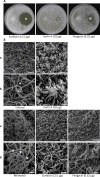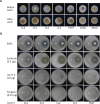Biological control of potato common scab by Bacillus amyloliquefaciens Ba01
- PMID: 29698535
- PMCID: PMC5919641
- DOI: 10.1371/journal.pone.0196520
Biological control of potato common scab by Bacillus amyloliquefaciens Ba01
Abstract
Potato common scab, which is caused by soil-borne Streptomyces species, is a severe plant disease that results in a significant reduction in the economic value of potatoes worldwide. Due to the lack of efficacious pesticides, crop rotations, and resistant potato cultivars against the disease, we investigated whether biological control can serve as an alternative approach. In this study, multiple Bacillus species were isolated from healthy potato tubers, and Bacillus amyloliquefaciens Ba01 was chosen for further analyses based on its potency against the potato common scab pathogen Streptomyces scabies. Ba01 inhibited the growth and sporulation of S. scabies and secreted secondary metabolites such as surfactin, iturin A, and fengycin with potential activity against S. scabies as determined by imaging mass spectrometry. In pot assays, the disease severity of potato common scab decreased from 55.6 ± 11.1% (inoculated with S. scabies only) to 4.2 ± 1.4% (inoculated with S. scabies and Ba01). In the field trial, the disease severity of potato common scab was reduced from 14.4 ± 2.9% (naturally occurring) to 5.6 ± 1.1% after Ba01 treatment, representing evidence that Bacillus species control potato common scab in nature.
Conflict of interest statement
Figures







Similar articles
-
Surfactin secreted by Bacillus amyloliquefaciens Ba01 is required to combat Streptomyces scabies causing potato common scab.Front Plant Sci. 2022 Nov 1;13:998707. doi: 10.3389/fpls.2022.998707. eCollection 2022. Front Plant Sci. 2022. PMID: 36388520 Free PMC article.
-
Bacillus safensis LS01 provides biological control of potato common scab with potential effects from secondary metabolites.J Appl Microbiol. 2024 Dec 2;135(12):lxae307. doi: 10.1093/jambio/lxae307. J Appl Microbiol. 2024. PMID: 39701816
-
Characterizing a novel strain of Bacillus amyloliquefaciens BAC03 for potential biological control application.J Appl Microbiol. 2012 Nov;113(5):1165-75. doi: 10.1111/j.1365-2672.2012.05420.x. Epub 2012 Aug 24. J Appl Microbiol. 2012. PMID: 22924833
-
Isolation and identification of an endophytic bacteria Bacillus sp. K-9 exhibiting biocontrol activity against potato common scab.Arch Microbiol. 2022 Jul 14;204(8):483. doi: 10.1007/s00203-022-02989-5. Arch Microbiol. 2022. PMID: 35833995 Review.
-
Genetic and physiological determinants of Streptomyces scabies pathogenicity.Mol Plant Pathol. 2009 Sep;10(5):579-85. doi: 10.1111/j.1364-3703.2009.00561.x. Mol Plant Pathol. 2009. PMID: 19694949 Free PMC article. Review.
Cited by
-
Crop rotations increased soil ecosystem multifunctionality by improving keystone taxa and soil properties in potatoes.Front Microbiol. 2023 Feb 23;14:1034761. doi: 10.3389/fmicb.2023.1034761. eCollection 2023. Front Microbiol. 2023. PMID: 36910189 Free PMC article.
-
Management of take-all disease caused by Gaeumannomyces graminis var. tritici in wheat through Bacillus subtilis strains.Front Microbiol. 2023 Feb 1;14:1118176. doi: 10.3389/fmicb.2023.1118176. eCollection 2023. Front Microbiol. 2023. PMID: 36819043 Free PMC article.
-
A Potential Biocontrol Agent Streptomyces violaceusniger AC12AB for Managing Potato Common Scab.Front Microbiol. 2019 Feb 8;10:202. doi: 10.3389/fmicb.2019.00202. eCollection 2019. Front Microbiol. 2019. PMID: 30800116 Free PMC article.
-
Biocontrol Effect of Bacillus velezensis D7-8 on Potato Common Scab and Its Complete Genome Sequence Analysis.Microorganisms. 2025 Mar 28;13(4):770. doi: 10.3390/microorganisms13040770. Microorganisms. 2025. PMID: 40284607 Free PMC article.
-
Endophytic Bacillus velezensis strain B-36 is a potential biocontrol agent against lotus rot caused by Fusarium oxysporum.J Appl Microbiol. 2020 Apr;128(4):1153-1162. doi: 10.1111/jam.14542. Epub 2019 Dec 19. J Appl Microbiol. 2020. PMID: 31808212 Free PMC article.
References
-
- Loria R, Kers J, Joshi M. Evolution of plant pathogenicity in Streptomyces. Annu Rev Phytopathol. 2006;44:469–87. doi: 10.1146/annurev.phyto.44.032905.091147 - DOI - PubMed
-
- Lambert DH, Loria R, Labeda DP, Saddler GS. Recommendation for the conservation of the name Streptomyces scabies. Request for an Opinion. Int J Syst Evol Microbiol. 2007;57(Pt 10):2447–8. doi: 10.1099/ijs.0.65275-0 - DOI - PubMed
-
- Bignell DR, Seipke RF, Huguet-Tapia JC, Chambers AH, Parry RJ, Loria R. Streptomyces scabies 87–22 contains a coronafacic acid-like biosynthetic cluster that contributes to plant-microbe interactions. Mol Plant Microbe Interact. 2010;23(2):161–75. doi: 10.1094/MPMI-23-2-0161 - DOI - PubMed
-
- Bignell DR, Fyans JK, Cheng Z. Phytotoxins produced by plant pathogenic Streptomyces species. J Appl Microbiology. 2014;116(2):223–35. - PubMed
-
- King RR, Calhoun LA. The thaxtomin phytotoxins: sources, synthesis, biosynthesis, biotransformation and biological activity. Phytochemistry. 2009;70(7):833–41. doi: 10.1016/j.phytochem.2009.04.013 - DOI - PubMed
Publication types
MeSH terms
Substances
LinkOut - more resources
Full Text Sources
Other Literature Sources

